Solar eclipse of June 21, 2020
An annular solar eclipse occurred on Sunday, June 21, 2020.[1][2][3][4][5] An annular solar eclipse is a solar eclipse whose presentation looks like a ring, or annulus; it occurs when the Moon's apparent diameter is smaller than the Sun's, blocking most, but not all, of the Sun's light. In this instance, the Moon's apparent diameter was 0.6% smaller than the Sun's.[6]

| Solar eclipse of June 21, 2020 | |
|---|---|
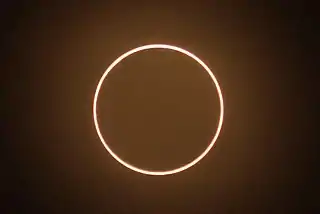 Annularity as seen from Beigang, Yunlin, Taiwan | |
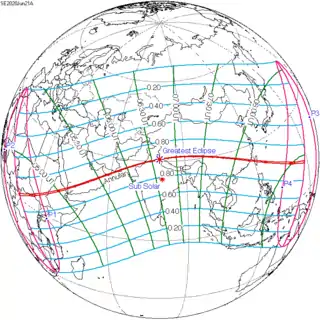 Map | |
| Type of eclipse | |
| Nature | Annular |
| Gamma | 0.1209 |
| Magnitude | 0.994 |
| Maximum eclipse | |
| Duration | 38 sec (0 m 38 s) |
| Coordinates | 30.5°N 79.7°E |
| Max. width of band | 21 km (13 mi) |
| Times (UTC) | |
| Greatest eclipse | 6:41:15 |
| References | |
| Saros | 137 (36 of 70) |
| Catalog # (SE5000) | 9553 |
Path
The path of this annular eclipse passed through parts of Central and Eastern Africa; southern Arabian Peninsula, including Yemen, Oman, and southern Saudi Arabia; parts of South Asia and the Himalayas, including southern Pakistan, northern India, and Nepal; parts of East Asia, including South China and Taiwan, and part of Micronesia, including Guam.[7] A partial eclipse was visible throughout much of the rest of Africa, southeastern Europe, most of Asia, and in New Guinea and northern Australia just before sunset. In Europe, the partial eclipse was visible to places southeast of the line passing through parts of Italy, Hungary, Ukraine, and southwestern Russia.[7]
Gallery
.jpg.webp) Partial from Addis Ababa, Ethiopia, 4:53 UTC
Partial from Addis Ababa, Ethiopia, 4:53 UTC Partial from Sana'a, Yemen, 5:09 UTC
Partial from Sana'a, Yemen, 5:09 UTC Partial from Riyadh, Saudi Arabia, 5:11 UTC
Partial from Riyadh, Saudi Arabia, 5:11 UTC Eclipse progression from Tehran, Iran
Eclipse progression from Tehran, Iran Partial from Gyumri, Armenia, 5:45 UTC
Partial from Gyumri, Armenia, 5:45 UTC Partial from Colombo, Sri Lanka, 5:48 UTC
Partial from Colombo, Sri Lanka, 5:48 UTC_(cropped).jpg.webp) Partial from Lahore, Pakistan, 6:49 UTC
Partial from Lahore, Pakistan, 6:49 UTC Partial from Kathmandu, Nepal, 6:51 UTC
Partial from Kathmandu, Nepal, 6:51 UTC Partial from Irkutsk, Russia, ~7:22 UTC
Partial from Irkutsk, Russia, ~7:22 UTC Partial from Bacoor, Philippines, 7:31 UTC
Partial from Bacoor, Philippines, 7:31 UTC Partial from Kolkata, India, 7:42 UTC
Partial from Kolkata, India, 7:42 UTC Telescopic view from Chennai, India
Telescopic view from Chennai, India.jpg.webp) Partial from Beijing, China, 7:51 UTC
Partial from Beijing, China, 7:51 UTC Partial from Jinan, China, 7:56 UTC
Partial from Jinan, China, 7:56 UTC Partial from Tai'an, China, 7:57 UTC
Partial from Tai'an, China, 7:57 UTC.jpg.webp) Partial from Gandara, Samar, Philippines, 8:01 UTC
Partial from Gandara, Samar, Philippines, 8:01 UTC.jpg.webp) Partial from Kaohsiung, Taiwan, 8:05 UTC
Partial from Kaohsiung, Taiwan, 8:05 UTC Partial from Yau Tong, Hong Kong, 8:08 UTC
Partial from Yau Tong, Hong Kong, 8:08 UTC.jpg.webp) Partial from Taichung, Taiwan, 8:09 UTC
Partial from Taichung, Taiwan, 8:09 UTC Partial from Pangkalpinang, Indonesia, 8:10 UTC
Partial from Pangkalpinang, Indonesia, 8:10 UTC.jpg.webp) Xiamen, China, 8:11 UTC
Xiamen, China, 8:11 UTC Time-lapse image of the eclipse in Xiamen, China
Time-lapse image of the eclipse in Xiamen, China.jpg.webp) Partial from Fukuoka, Japan, 8:12 UTC
Partial from Fukuoka, Japan, 8:12 UTC.jpg.webp) Chiayi, Taiwan, 8:13 UTC
Chiayi, Taiwan, 8:13 UTC Partial from Hsinchu, Taiwan, 8:18 UTC
Partial from Hsinchu, Taiwan, 8:18 UTC Partial from Surabaya, Indonesia, 8:22 UTC
Partial from Surabaya, Indonesia, 8:22 UTC Partial from San Jose del Monte, Philippines, 8:23 UTC
Partial from San Jose del Monte, Philippines, 8:23 UTC.jpg.webp) Eclipse progression from Oria, Italy
Eclipse progression from Oria, Italy_The_solar_eclipse_shadows_a_portion_of_Asia.jpg.webp)

Related eclipses
Eclipses of 2020
Tzolkinex
- Preceded: Solar eclipse of May 10, 2013
- Followed: Solar eclipse of August 2, 2027
Half-Saros cycle
- Preceded: Lunar eclipse of June 15, 2011
- Followed: Lunar eclipse of June 26, 2029
Tritos
- Preceded: Solar eclipse of July 22, 2009
- Followed: Solar eclipse of May 21, 2031
Solar Saros 137
- Preceded: Solar eclipse of June 10, 2002
- Followed: Solar eclipse of July 2, 2038
Inex
- Preceded: Solar eclipse of July 11, 1991
- Followed: Solar eclipse of May 31, 2049
Triad
- Preceded: Solar eclipse of August 21, 1933
- Followed: Solar eclipse of April 23, 2107
Solar eclipses of 2018–2021
This eclipse is a member of a semester series. An eclipse in a semester series of solar eclipses repeats approximately every 177 days and 4 hours (a semester) at alternating nodes of the Moon's orbit.[8]
Note: Partial solar eclipses on February 15, 2018, and August 11, 2018, occurred during the previous semester series.
| Ascending node | Descending node | |||||
|---|---|---|---|---|---|---|
| Saros | Map | Gamma | Saros | Map | Gamma | |
117.jpg.webp) Partial from Melbourne, Australia |
2018 July 13 Partial |
−1.35423 | 122 Partial from Nakhodka, Russia |
2019 January 6 Partial |
1.14174 | |
127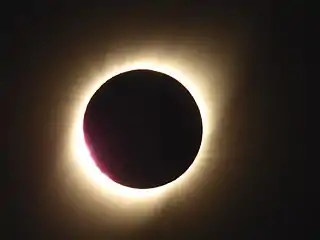 La Serena, Chile |
2019 July 2 Total |
−0.64656 | 132.jpg.webp) Jaffna, Sri Lanka |
2019 December 26 Annular |
0.41351 | |
137 Beigang, Yunlin, Taiwan |
2020 June 21 Annular |
0.12090 | 142 Gorbea, Chile |
2020 December 14 Total |
−0.29394 | |
147_(cropped).jpg.webp) Partial from Halifax, Canada |
2021 June 10 Annular |
0.91516 | 152.jpg.webp) From HMS Protector off South Georgia |
2021 December 4 Total |
−0.95261 | |
Saros 137
It is a part of Saros cycle 137, an eclipse series repeating every 18 years and 11 days, containing 70 events. The series started with the partial solar eclipse on May 25, 1389. It contains total eclipses from August 20, 1533, through December 6, 1695, the first set of hybrid eclipses from December 17, 1713, through February 11, 1804, the first set of annular eclipses from February 21, 1822, through March 25, 1876, a second set of hybrid eclipses from April 6, 1894, through April 28, 1930, and the second set of annular eclipses from May 9, 1948, through April 13, 2507. The series ends at member 70 as a partial eclipse on June 28, 2633. All eclipses in this series occurs at the Moon’s ascending node.
| Series members 30–40 occur between 1901 and 2100: | ||
|---|---|---|
| 30 | 31 | 32 |
 April 17, 1912 |
 April 28, 1930 |
 May 9, 1948 |
| 33 | 34 | 35 |
 May 20, 1966 |
 May 30, 1984 |
 June 10, 2002 |
| 36 | 37 | 38 |
 June 21, 2020 |
 July 2, 2038 |
 July 12, 2056 |
| 39 | 40 | |
 July 24, 2074 |
 August 3, 2092 | |
Inex series
This eclipse is a part of the long period inex cycle, repeating at alternating nodes, every 358 synodic months (≈ 10,571.95 days, or 29 years minus 20 days). Their appearance and longitude are irregular due to a lack of synchronization with the anomalistic month (period of perigee). However, groupings of 3 inex cycles (≈ 87 years minus 2 months) comes close (≈ 1,151.02 anomalistic months), so eclipses are similar in these groupings. In the 18th century:
- Solar Saros 127: Total Solar Eclipse of 1731 Jan 08
- Solar Saros 128: Annular Solar Eclipse of 1759 Dec 19
- Solar Saros 129: Annular Solar Eclipse of 1788 Nov 27
| Inex series members between 1801 and 2200: | ||
|---|---|---|
| Near lunar perigee | After lunar apogee Before lunar perigee |
Before lunar apogee After lunar perigee |
 November 9, 1817 (Saros 130) |
 October 20, 1846 (Saros 131) |
 September 29, 1875 (Saros 132) |
 September 9, 1904 (Saros 133) |
 August 21, 1933 (Saros 134) |
 July 31, 1962 (Saros 135) |
 July 11, 1991 (Saros 136) |
 June 21, 2020 (Saros 137) |
 May 31, 2049 (Saros 138) |
 May 11, 2078 (Saros 139) |
 April 23, 2107 (Saros 140) |
 April 1, 2136 (Saros 141) |
 March 12, 2165 (Saros 142) |
 February 21, 2194 (Saros 143) |
|
In the 23rd century:
- Solar Saros 144: Annular Solar Eclipse of 2223 Feb 01
- Solar Saros 145: Total Solar Eclipse of 2252 Jan 12
- Solar Saros 146: Annular Solar Eclipse of 2280 Dec 22
Metonic series
The metonic series repeats eclipses every 19 years (6939.69 days), lasting about 5 cycles. Eclipses occur in nearly the same calendar date. In addition, the octon subseries repeats 1/5 of that or every 3.8 years (1387.94 days). All eclipses in this table occur at the Moon's ascending node.
| 21 eclipse events between June 21, 1982, and June 21, 2058 | ||||
|---|---|---|---|---|
| June 21 | April 8–9 | January 26 | November 13–14 | September 1–2 |
| 107 | 109 | 111 | 113 | 115 |
| June 21, 1963 | April 9, 1967 | January 26, 1971 | November 14, 1974 | September 2, 1978 |
| 117 | 119 | 121 | 123 | 125 |
 June 21, 1982 |
 April 9, 1986 |
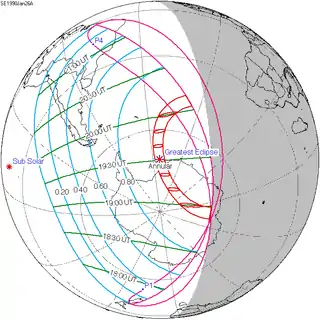 January 26, 1990 |
 November 13, 1993 |
 September 2, 1997 |
| 127 | 129 | 131 | 133 | 135 |
 June 21, 2001 |
 April 8, 2005 |
 January 26, 2009 |
 November 13, 2012 |
 September 1, 2016 |
| 137 | 139 | 141 | 143 | 145 |
 June 21, 2020 |
 April 8, 2024 |
 January 26, 2028 |
 November 14, 2031 |
 September 2, 2035 |
| 147 | 149 | 151 | 153 | 155 |
 June 21, 2039 |
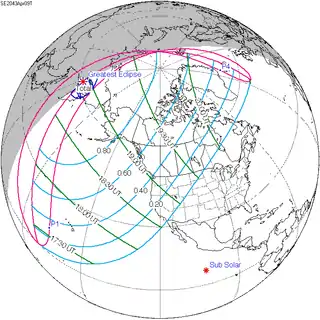 April 9, 2043 |
 January 26, 2047 |
 November 14, 2050 |
 September 2, 2054 |
| 157 | ||||
 June 21, 2058 | ||||
References
- Rao, Joe (June 20, 2020). "'Ring of fire' solar eclipse 2020: Here's how it works (and what to expect)". Space.com.
- Elassar, Alaa (June 21, 2020). "Astronauts are spending Father's Day in space watching the solar eclipse". CNN.
- Taylor, Alan. "Photos: A Solstice 'Ring of Fire' Solar Eclipse - The Atlantic". www.theatlantic.com.
- "Cloudy skies block view of annular solar eclipse in Hyderabad". June 22, 2020 – via The Economic Times - The Times of India.
- "Annular solar eclipse prompts excitement across Taiwan". Taiwan News. June 21, 2020.
- "Annular solar eclipse of 2020 Jun 21". Retrieved 2021-06-22.
- "Annular Solar Eclipse on June 21, 2020". www.timeanddate.com. Retrieved 2019-12-26.
- van Gent, R.H. "Solar- and Lunar-Eclipse Predictions from Antiquity to the Present". A Catalogue of Eclipse Cycles. Utrecht University. Retrieved 6 October 2018.
External links
- Earth visibility chart and eclipse statistics Eclipse Predictions by Fred Espenak, NASA/GSFC


.jpg.webp)

